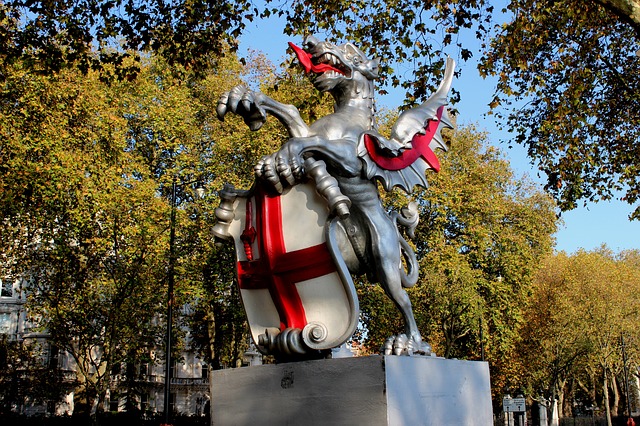St George’s Day takes place on April 23rd every year, celebrating the patron saint of England, made famous for slaying a dragon and saving a maiden in distress. If you happen to be in England on this national day of celebration, you will not miss the wave of English flags across the country, lines of stalls selling traditional English food, live performances, and parades of people on the streets, dancing and celebrating the patron saint of England. However, very little is known about St. George, the annual celebration and if he really slayed a dragon!
History of St. George:
St George is believed to have been born in Palestine in the 3rd Century AD and grew up to be a brave and valiant soldier in the Roman Army. He was later persecuted for his Christian faith and was beheaded for refusing to renounce his faith. His life and suffering have inspired several legends as well as medals for bravery and valor, which are awarded to civilians who have demonstrated extraordinary bravery and courage in the face of terror.
What’s he got to do with England?
St. George is not English and he has never set foot in England in his entire life. However, he represents the traditional English chivalry and bravery, which is why he is celebrated in England. He was made the patron saint of England by King Edward III in 1350 when he formed the Order of the Gartner in St. George’s name. England’s flag bears the Red Cross emblem that Saint Geroge wore on his shield, which was adopted by Richard the Lionheart in the 12th century to distinguish his soldiers in the battle from that of the enemy.
What is St George’s Day?
Saint George’s Day is the feast day of Saint George and is celebrated by various Christian Churches and several countries and cities where Saint George is the patron saint, including England. The day is celebrated on April 23 each year and this is the date traditionally accepted of his death in AD 303. Countries around the world including Iraq, Jordan, Palestine, Portugal, Lithuania, Romania, Syria, Germany, Greece, Istanbul, and Ethiopia also celebrate him.
How is St. George’s Day celebrated?
Traditionally, Saint George’s Day was marked by wearing a red rose on your lapel as it was believed that a beautiful bloom of red roses grew on his grave. The tradition also came from a Spanish custom in Catalonia in Spain – of which St. George is also a patron saint – where women were given roses by men in exchange for books on the feast day. More popular customs include flying the Saint George’s flag, street performances, arts/crafts activities, parades and food stalls selling traditional English food. It is common for cathedrals, churches, and chapels to play “Jerusalem” on Saint George’s Day.
Did he really kill a Dragon?
The earliest legend that features Saint George slaying a dragon dates to the 11th century. The tale may have started simply as a way to symbolize the triumph of good over evil. But, the well-known story mainly comes down to the Golden Legend – a popular collection of saints’ lives written in the 13th century by Jacobus de Voragine. According to the myth, a small countryside town had a lake inhabited by a dragon infected with the plague. Many of the townsfolk were being killed by the dragon so they started feeding it two sheep a day to appease it. When the town ran out of sheep, legend has it that the king devised a lottery system to feed the hungry dragon, local children, instead. But, one day his own daughter was chosen and as she was being led down to the lake, Saint George happened to ride past. The story goes that St. George arrived just as the princess was about to be eaten by the dragon and like a true hero, saved the princess and slew the dragon, in the nick of time! The King is said to have built a church of Our Lady and St. George in his honor and the brave act.
What other interesting myths/rumors have you heard about St. George? Let us know in the comments below.
Andrie Steliou
Latest posts by Andrie Steliou (see all)
- 8 Ways to Help Keep Your Child Focused and Engaged in Online Learning - October 19, 2022
- How to Improve Social Intelligence Skills? - May 10, 2022
- How to Improve Organizational Skills at Workplace? - May 6, 2022

